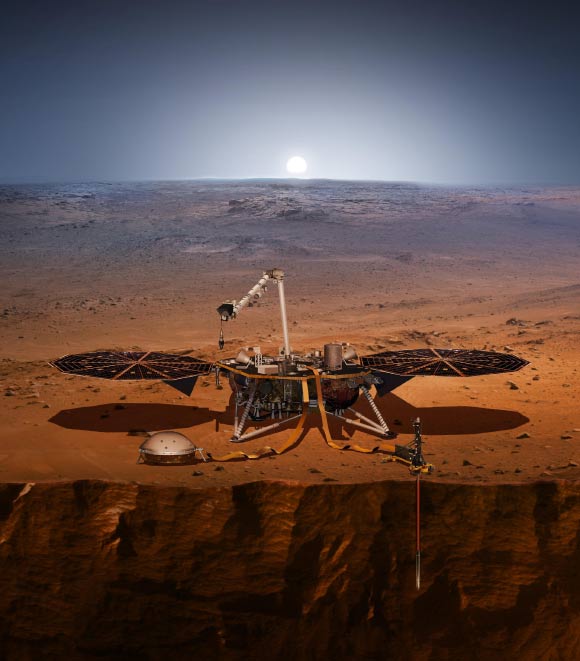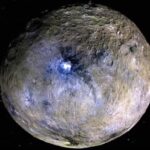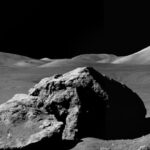During its time on Mars, NASA’s InSight (Interior Exploration using Seismic Investigations, Geodesy and Heat Transport) lander recorded over 1,300 seismic events, known as marsquakes. Of these, a number were identified as coming from meteoroid impact cratering events on the planet’s surface. The largest event identified by InSight, labeled S1222a, bore some similarities to two large impact events recorded earlier in the mission. In order to investigate whether the S1222a event might also have been caused by an impact event, planetary scientists from the University of Oxford and elsewhere undertook a comprehensive search of the region in which the S1222a marsquake occurred. The researchers did not identify any fresh craters in the area, implying that the marsquake was likely caused by geological processes.
An artist’s impression of the InSight lander on Mars. Image credit: NASA / JPL-Caltech.
On May 4, 2022, InSight recorded the seismic waves from an event on Mars of magnitude 4.7.
This event, labeled S1222a in the catalog, was the largest of the mission and displayed characteristics spanning all previously identified marsquake families. The event also displayed clear evidence of surface waves.
Because its seismic signal was similar to previous quakes known to be caused by meteoroid impacts, the InSight team believed that S1222a might have been caused by an impact as well, and launched an international search for a fresh crater.
Although Mars is smaller than Earth, it has a similar land surface area because it has no oceans.
In order to survey this huge amount of ground (144 million km2), University of Oxford researcher Benjamin Fernando and colleagues sought contributions from ESA, the Chinese National Space Agency, the Indian Space Research Organisation, and the United Arab Emirates Space Agency.
This is thought to be the first time that all missions in orbit around Mars have collaborated on a single project.
Each group examined data from their satellites orbiting Mars to look for a new crater, or any other tell-tale signature of an impact (e.g. a dust cloud appearing in the hours after the quake).
After several months of searching, the scientists announced that no fresh crater was found.
They conclude that the S1222a event was instead caused by the release of enormous tectonic forces within Mars’ interior.
The results indicate that the Red Planet is much more seismically active than previously thought.

This spectrogram shows the magnitude 5 marsquake discovered by NASA’s InSight lander on May 4, 2022. Image credit: NASA / JPL-Caltech / ETH Zurich.
“We still think that Mars doesn’t have any active plate tectonics today, so this event was likely caused by the release of stress within Mars’ crust,” Dr. Fernando said.
“These stresses are the result of billions of years of evolution; including the cooling and shrinking of different parts of the planet at different rates.”
“We still do not fully understand why some parts of the planet seem to have higher stresses than others, but results like these help us to investigate further.”
“One day, this information may help us to understand where it would be safe for humans to live on Mars and where you might want to avoid!”
“This experiment shows how important it is to maintain a diverse set of instruments at Mars, and we are very glad to have played our part in completing the multi-instrumental and international approach of this study,” said Dr. Daniela Tirsch, science coordinator for the High Resolution Stereo Camera on board ESA’s Mars Express spacecraft.
“We are willing to collaborate with scientists around the world to share and apply this scientific data to get more knowledge about Mars, and are proud to have provided data from the color imagers on Tianwen-1 to contribute to this effort,” said Dr. Jianjun Liu, an astronomer at the National Astronomical Observatories of the Chinese Academy of Sciences.
“This has been a great opportunity for me to collaborate with the InSight team, as well as with individuals from other major missions dedicated to the study of Mars,” said Dr. Dimitra Atri, group leader for Mars at New York University Abu Dhabi and contributor of data from UAE’s Hope spacecraft.
“This really is the golden age of Mars exploration!”
The results appear in the journal Geophysical Research Letters.
_____
Benjamin Fernando et al. 2023. A Tectonic Origin for the Largest Marsquake Observed by InSight. Geophysical Research Letters 50 (20): e2023GL103619; doi: 10.1029/2023GL103619




